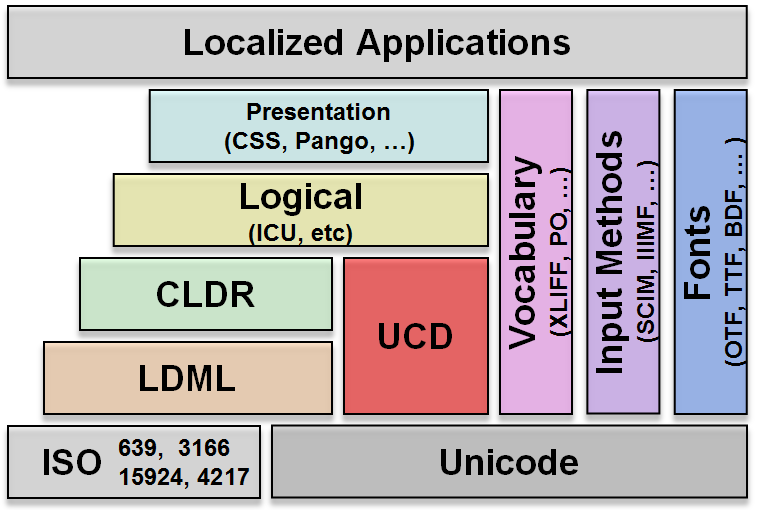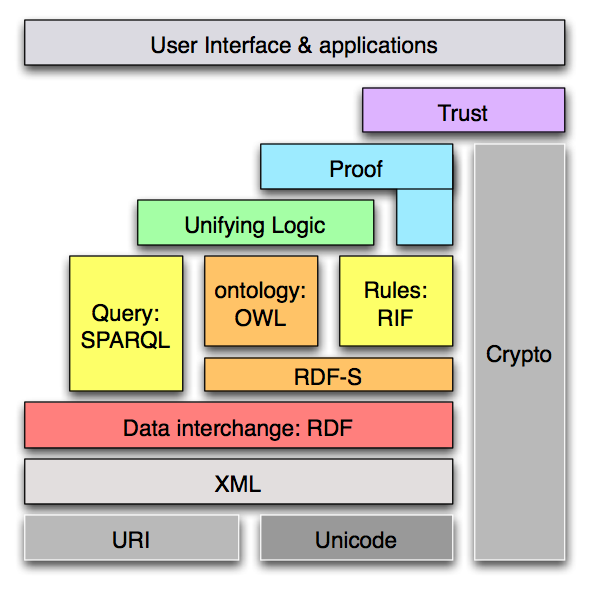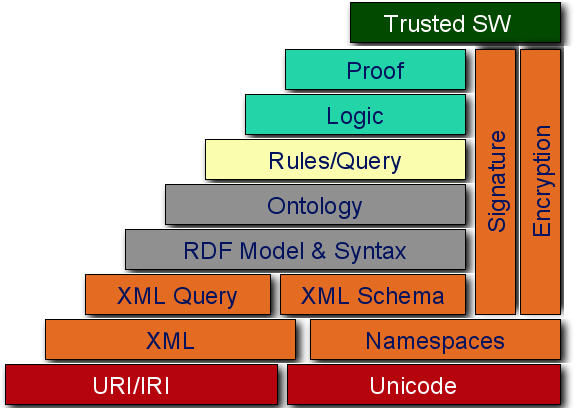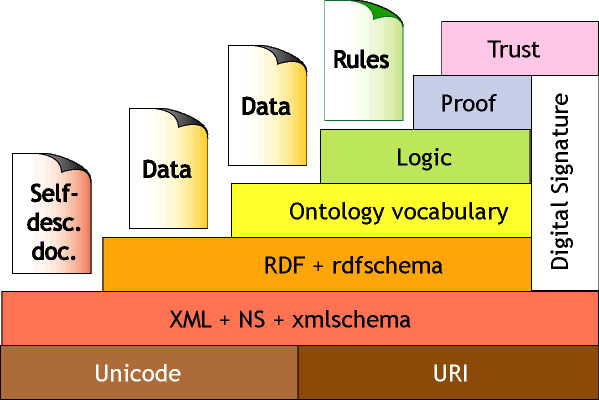An Enabling Standards Layer Cake for L10N
What is a "Layer Cake"?
The Semantic Web's "Enabling Standards Layer Cake" refers
to the simple visual model used to show the dependency associations of the family
of technology standards that comprise the semantic web. The image is also a roadmap where
each layer is a progress milestone in the realization of the complete semantic web.
The model is not intended to be an engineering reference, but is useful in
illustrating at a glance the relationships between technical areas for an audience
that may be new to and unfamiliar with the field.
Appendix A provides some samples of the semantic web
Enabling Standards Layer Cake as it has evolved over the years.
Why have a localization layer cake?
Like the semantic web, localization exists as a collection of various standards
and software resources. The associations and dependencies of which are not immediately
obvious to a person new to the field. The layer cake illustration offers a
representative mental picture that they may refer to when considering the various
facets of localization.
The Layers
The layers of a localization layer cake would represent the open standards and
resources that make a fully internationalized and thus localizable application
possible. To keep the model simple, the number of layers is kept to a minimum
and a single layer may encompass several related standards.
- Unicode:
- The encoding system that underlies all character representation in a localized resource.
- ISO:
-
The collection of standards that codify locale identification and locale entities.
Specifically ISO-639, ISO-3166, ISO-4217 and ISO-15924 which along with ISO-10646
(most widely known via Unicode) form a "localization family" of standards.
The ISO standards are low-level and do not have a direct dependency on Unicode encoding
and so are positioned at the same level.
- LDML:
-
The Locale Data Markup Language, the XML schema for encapsulating locale data.
LDML relies on the ISO standards for identifying data and uses Unicode for the encoding
of data.
- CLDR:
-
The Common Locale Data Repository provides the language and region specific conventions
for formatting dates, times, currencies and numbers along with translations of the ISO
identifier referents. CLDR data is provided in the form of LDML document instances.
- UCD:
-
The Unicode Character Database defines character properties such as symbol type
(letter, number, punctuation), case mappings, directionality, etc.
The UCD layer depends on Unicode and is utilized by ICU.
- Logical:
-
The logical layer is the level where character and locale information processing
occur for use by application. Here APIs and algorithms reside for accessing
the locale data of CLDR, as well as for services such as calendar conversions
and character normalization.
- Presentation:
-
The presentation layer is where multilingual lay out is defined and processed
such that the text appears visually natural as per viewer expectations.
- Fonts:
-
The font and other vertical layers have a dependency on Unicode but not the
other horizontal layers though may interact with the logical and presentation
layers as coordinated by localized application.
- Input Methods:
-
The Input Method layer has both Unicode and ISO dependencies. Input methods
assume the presence of fonts to be useful, but only depend on a fonts
underlying encoding.
- Vocabulary:
-
The application vocabulary layer also has Unicode and ISO dependencies and
require an input method for terminology composition as well as fonts for the
display of terms.
The Cake (Draft 2006/11/12)

A shadowless version of the above image,
and the PowerPoint sources of the images.
Enhancing the Cake
Improvements can be made upon the model but additional detail should not be added at the loss
to its simplicity. Also, the layer cake has a Unicode/OpenI18N slant to it and tries to avoid
referencing proprietary systems. Some considerations for enhancement are:
- Are layers missing?
- Do the associations need adjusting?
- The UCD block should also include the sundry Unicode TRs.
- Is SCIM Unix only?
- Zoom views could be made, for example to illustrate the facets of ICU (calendars,
collation, transliteration, etc.).
Any and all comments and feedback are welcome, please send to  .
.
Appendix A: Reference Layer Cakes
The Semantic Web Enabling Standards Layer Cake - 2006

http://www.w3.org/2006/Talks/0718-aaai-tbl/Overview.html#(14)
The Semantic Web Enabling Standards Layer Cake - 2004

http://en.wikipedia.org/wiki/Semantic_Web
The Semantic Web Enabling Standards Layer Cake - 2001

http://www.w3.org/2001/09/06-ecdl/slide17-0.html
 .
.

 .
.


